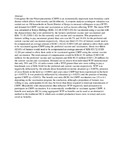| dc.contributor.author | Kairu-Wanyoike, Salome W | |
| dc.contributor.author | Kaitibie, Simeon | |
| dc.contributor.author | Heffernan, Claire | |
| dc.contributor.author | Taylor, Nick M. | |
| dc.contributor.author | Gitau, George K | |
| dc.contributor.author | Kiara, Henry | |
| dc.contributor.author | McKeever, Declan | |
| dc.date.accessioned | 2014-04-08T10:07:50Z | |
| dc.date.available | 2014-04-08T10:07:50Z | |
| dc.date.issued | 2014 | |
| dc.identifier.citation | Preventive Veterinary Medicine Available online 6 April 2014 | en_US |
| dc.identifier.uri | http://www.sciencedirect.com/science/article/pii/S016758771400138X | |
| dc.identifier.uri | http://hdl.handle.net/11295/65885 | |
| dc.description.abstract | Contagious Bovine Pleuropneumonia (CBPP) is an economically important trans-boundary cattle disease which affects food security and livelihoods. A conjoint analysis-contingent valuation was carried out on 190 households in Narok District of Kenya to measure willingness to pay (WTP) and demand for CBPP vaccine and vaccination as well as factors affecting WTP. The mean WTP was calculated at Kenya Shillings (KSh) 212.48 (USD 3.03) for vaccination using a vaccine with the characteristics that were preferred by the farmers (preferred vaccine and vaccination) and KSh -71.45 (USD-1.02) for the currently used vaccine and vaccination. The proportion of farmers willing to pay an amount greater than zero was 66.7% and 34.4% for the preferred and current vaccine and vaccination respectively. About one third (33.3%) of farmers would need to be compensated an average amount of KSh 1,162.62 (USD13.68) per animal to allow their cattle to be vaccinated against CBPP using the preferred vaccine and vaccination. About two-thirds (65.6%) of farmers would need to be compensated an average amount of KSh 853.72 (USD 12.20) per animal to allow their cattle to be vaccinated against CBPP using the current vaccine and vaccination. The total amount of compensation would be KSh 61.39 million (USD 0.88 million) for the preferred vaccine and vaccination and KSh 90.15 million (USD 1.29 million) for the current vaccine and vaccination. Demand curves drawn from individual WTP demonstrated that only 59% and 27% of cattle owners with a WTP greater than zero were willing to pay a benchmark cost of KSh 34.60 for the preferred and current vaccine respectively. WTP was negatively influenced by the attitude about household economic situation (p = 0.0078), presence of cross breeds in the herd (p < 0.0001) and years since CBPP had been experienced in the herd (p = 0.0375). It was positively influenced by education (p = 0.0251) and the practice of treating against CBPP (p = 0.0432). The benefit cost ratio (BCR) for CBPP vaccination was 2.9 to 6.1 depending on the vaccination program. In conclusion, although a proportion of farmers was willing to pay, participation levels may be lower than those required to interrupt transmission of CBPP. Households with characteristics that influence WTP negatively need persuasion to participate in CBPP vaccination. It is economically worthwhile to vaccinate against CBPP. A benefit cost analysis (BCA) using aggregated WTP as benefits can be used as an alternative method to the traditional BCA which uses avoided production losses (new revenue) and costs saved as benefits. | en_US |
| dc.language.iso | en | en_US |
| dc.publisher | University of Nairobi | en_US |
| dc.subject | Contagious Bovine Pleuropneumonia; Conjoint Analysis-Contingent Valuation; Willingness to Pay; Vaccine; Vaccination; Narok; Kenya | en_US |
| dc.title | Willingness to Pay for Contagious Bovine Pleuropneumonia Vaccination in Narok South District of Kenya | en_US |
| dc.type | Article | en_US |

